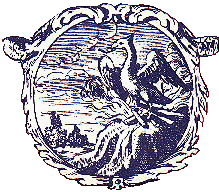![]()
![]()
![]()
![]()
![]()
Spices enjoyed high esteem in early kitchens, but the amount of time, travel & trade involved in bringing them to European households meant that for many people, their origins were steeped in mystery. Most varieties of spices were imported by foreign merchants from distant, unknown sources and by the time had reached their final destination had gained the reputation of having mystical, almost occult-like, & barely fathomable properties. Medieval physicists loved any information on spices and were content to believe in even the most fantastic "facts," usually embellishing them with even more incredible details. Even the most common of spices, such as cinnamon, became objects of folklore: "Pliny speketh of canel (cinnamon) and seith of canel and of cassia men tolde fables in old tyme, that is yfounde in briddes nests and specialle in the fenix (phoenix) his nest, and may nought be yfounde but what falleth by his owne wight or is ysmyte down with leded arwes (arrows)."
The Phoenix and its nest -  -
the origin of cinnamon?
-
the origin of cinnamon?
The 16th century English encyclopedist Bartholomaeus de Glanville, known as Bartholomew the Englishman, believed that black pepper was the result of white pepper having been scorched by fire. According to Bartholomew, the peppercorn was the fruit of a tree that grew in a forest on the south slope of the hill Caucasus; this forest was the home of a vicious breed of snakes that had to be driven out by fire in order for the peppercorns to be harvested. This fire transformed white pepper into the wrinkled black variety.
Even by the 13th century the origin of the more common foreign spices remained a mystery (at least for those not directly involved in their commerce). The biography Life of Saint Loius, completed in 1309 by Jean, Sire of Joinville and Seneschal of Champagne, spoke of the Nile River and said "before this river enters Egypt, the people who usually do such work cast their nets of an evening into the water and let them lie outspread. When morning comes they find in their nets such things as are sold by weight and imported into Egypt, as for instance ginger, rhubabrb, aloes and cinnamon. It is said these things come from the Earthly Paradise."

a Medieval depiction of the Nile River
![]()
![]()
BACK to The Amber Tree | RETURN to Mythical Plants of the Middle Ages
This page © 2000 James L. Matterer
Please visit The Gode Cookery Bookshop | This site hosted by Visual Presence